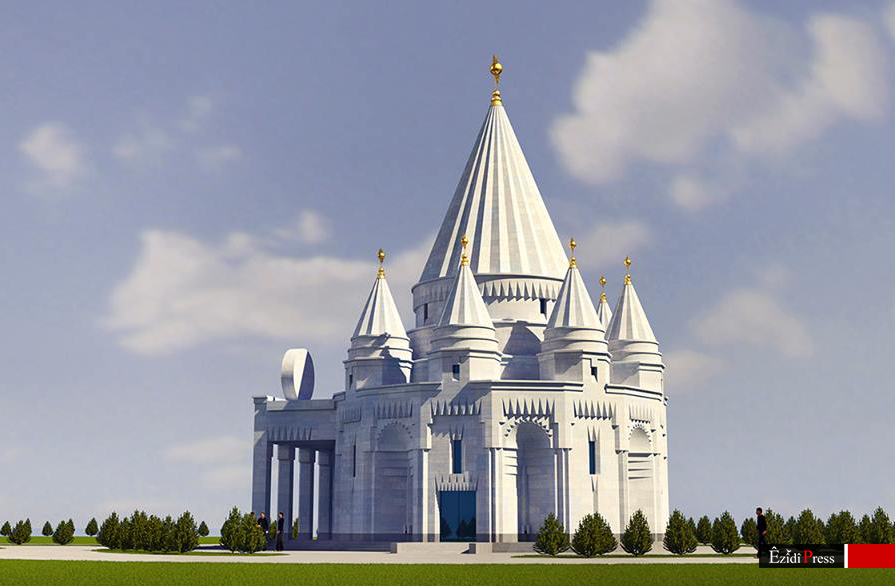Armenia to House World’s Largest Yazidi Temple

By
Eurasianet
The small village of Aknalich, about 35 kilometers (22 miles) west of Armenia’s capital, Yerevan, will soon be home to the world’s largest Yazidi temple. For a people striving to rebound after a 2014 massacre by Islamic State militants in Iraq, the structure is a symbol of resilience.
Yazidis are one of Armenia’s largest ethnic minority groups, practicing an ancient, monotheistic faith that has similarities to Christianity, Islam and Judaism, along with elements of sun worship. Numbering around 35,000, according to Armenia’s 2011 census, they live mostly in the South Caucasus country’s western and northern regions.
Theirs is a tragic history. Yazidis were a persecuted minority in the Ottoman Empire and reached what is today Armenia in the 1820s. Persecution continues to this day. In August 2014, Islamic State (IS) fighters entered the northwestern Iraqi town of Sinjar and slaughtered thousands of Yazidi men and abducted a similar number of women, according to United Nations researchers. In June, the UN condemned IS terrorists’ anti-Yazidi campaigns in Iraq and Syria as genocide.
A small number of Yazidis fleeing the conflict have reached Armenia and its northern neighbor, Georgia, which also is home to a Yazidi temple. Most, though, do not stay for long, joining others in their search for a better life in the European Union.
Most residents of Aknalich, a mixed Yazidi-Armenian village of about 3,000, work in the agricultural sector. A few work at the nearby Metsamor nuclear plant. As is common in Armenia, many young people go to Russia in search of work, sending remittances back home.
Aknalich Mayor Gevork Misakian hopes that the temple will help slow the labor migration trend. Already, the village has the beginnings of a Yazidi cultural and religious center. Aside from the temple, a conference hall, museum and religious seminary are under construction. Weddings will also be held in the complex.
The village also contains the former Soviet Union’s first Yazidi temple, Ziyarat, erected in 2012. The symbolism of Ziyarat and Aknalich’s new temple, Quba Mere Diwane (roughly translated as “All Will Come Together”), has only increased since the Sinjar massacre, noted Khdr Hajoian, vice president of the Yazidi National Union, a Yerevan-based organization.
But the new temple, already under construction for nearly a year, is a project on a much larger scale.
Built of Armenian granite and Iranian marble, Quba Mere Diwane will stand 25.3 meters (83 feet) high and contain a prayer hall of 200 square meters (2,153 square feet). Seven domes will surround a large central dome representing Melek Taus, the most revered of the Yazidi angels. It will be crowned with a gold-plated sun, a symbol of the Yazidis’ faith.
Workers at the adjacent stonemasons’ yard do not expect the temple to be finished until 2017.
Its cost has not been made public. Financing for Quba Mere Diwane comes from 69-year-old Mirza Sloian, a successful Moscow-based Yazidi businessman, who also paid for Ziyarat. Sloian is a native of Armenia’s Armavir region.
The new structure, envisaged well before the Sinjar massacre, reflects the Yazidis’ current need to “feel that we are a community,” commented Mraz Sloian, nephew of the project’s financier. Fears of assimilation and of conversion by proselytizing evangelical Christian groups active in Armenia’s regions also played a part, he added.
Yazidis in the Caucasus were historically nomadic and never built mega-temples. Ethnographer Hranoush Kharatian, the former head of the Armenian government’s department for minority affairs, sees the project as part of a broader Yazidi attempt to institutionalize their faith, establishing a spiritual center for the country’s Yazidis for the first time.
Despite the concerns about assimilation, Armenia’s Yazidis identify strongly with their ethnic Armenian neighbors.
Community members are quick to point out that Yazidis share a common history of genocide with Armenians; many Yazidis were also killed amid the Ottoman-era mass slaughter of ethnic Armenians during World War I. It was no coincidence that construction on the Quba Mere Diwane temple began months after the centenary commemorations of that massacre.
The approach to the new temple stands in plain sight of Mount Ararat, just across the Turkish border. It is lined with monuments celebrating Armenian-Yazidi brotherhood such as an intertwined Armenian khachkar (cross) and sun.
That sense of fraternity often appears to work the other way, too. The Armenian parliament currently is reviewing a draft document on recognizing the Sinjar massacre as genocide.
Relations with the Armenian Apostolic Church, the country’s majority faith, are friendly. The Church’s patriarch, Catholicos Karekin II, and senior clergy attended the dedication of the monuments to Armenian-Yazidi brotherhood.
The new Yazidi temple’s architect is, in fact, better known for his work on Armenian Apostolic churches. Artak Ghulian designed Moscow’s new Armenian cathedral, and has built over 20 churches for many of Armenia’s big names, including a cathedral in Abovian financed by oligarch and politician Gagik Tsarukian.
Ghulian could not be reached for comment, although temple sponsor Sloian wrote in a 2015 book that the new temple’s style is inspired by the shrine at Lalish, the holiest of over 360 Yazidi shrines in northern Iraq.
Impressive though it will be, Quba Mere Diwane is not intended to overshadow Iraq’s historic Yazidi temples, stressed the Yazidi National Union’s Hajoian. “There will only ever be one Lalish,” he added. Sheikh Jendi Jendoian, a local religious leader from Artashar village, agreed that Lalish would always remain the holiest site for Yazidis.
Maxim Edwards is a writer and commissioning editor at openDemocracy Russia (oDR). He covers nationalism, minorities, and memory, with a focus on post-Soviet states.
